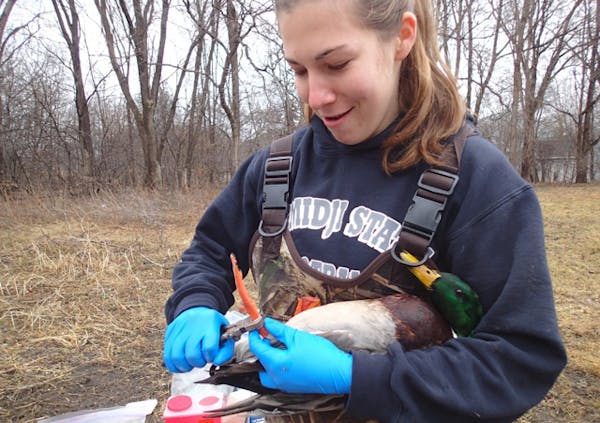Minnesota's earliest returning migratory birds are ahead of schedule, by a matter of weeks in some cases. So it's definitely time to keep an eye out for these joyous, natural signs of spring. Elite birder and author Bob Janssen of St. Louis Park, who last year published the popular "Birds of Minnesota State Parks" guide, shared his knowledge of five distinctive species — big and small — that come home early to their favorite ledge, stick ensemble, tree cavity, mud nest or bird box.
Sandhill cranes
Birding hot lines were full this year of fantastically early reports of returning sandhill cranes, an ancient species native to Minnesota that has returned to abundance after nearly being wiped out by hunters in the 1940s. In a normal spring, the early returns of these prehistoric-sounding creatures are in the first week of March, with peak migration across the state in late March and early April.
With their 7-foot wingspans and rattling calls, the rusty-colored birds winter in many different places in the south-central and southeastern U.S., in addition to northern Mexico. They migrate back to shallow wetlands and grasslands and often can be seen feeding in pastures or farm fields. The Department of Natural Resources' latest population estimate for Minnesota sandhill cranes is 15,000, and thousands of them flock to Sherburne National Wildlife Refuge in Zimmerman in fall to stage a return to their wintering grounds.
Eastern bluebird
The crowd-pleasing bluebirds usually return to Minnesota during the first couple of weeks in March in a classic sign of spring. A clutch of Twin Cities birders linked by social media already have been driving to a grassland park along the Mississippi River, south of St. Cloud, to see them. The interest was sparked by the sighting of a rare mountain bluebird, mixed in with the eastern bluebirds.
These cavity-nesters will winter in places as near as southern Iowa, and they are another songbird species very at ease around humans. Males are strikingly blue with burnt-orange feathers on their throats and breasts. Females also are blue but duller, and both genders have white bellies. The eastern bluebird is a thrush with a plaintive, whispery song that has a pleasant musical quality. The birds migrate across the Twin Cities and live in open woods, clearings, fields, gardens, roadsides and along streams. You normally won't find them in dense woods. Some bluebirds live in southern Minnesota year-round.
Great blue heron
Mid-March is right about the time these majestic birds, with their croaking calls and slow wingbeats, return to the Twin Cities and many other parts of Minnesota. Mostly blue-gray in color, they migrate and nest in colonies, usually in tall trees topped with big stick nests. The main group of blue herons that return here spend winters south of the permanent snow line in Missouri and other states. Some belong to well-known colonies, such as the one that exists in a large protected rookery on Pig's Eye Island near Battle Creek Regional Park in St. Paul. Herons have a variable diet that includes fish, frogs, snakes, crayfish, large insects — even gophers and other small mammals. The heron's head is light-colored with two black plumes coming off its crown and flowing backward. Their population has been stable, but raccoons and other predators have disrupted some colonies.
Wood duck
A number of these shy, brilliantly colored ducks never leave the state during the winter, choosing instead to move around in flowages that remain open, including artificially warmed waters near power plants. But most of our wood ducks winter south of the permanent snow line in southern Missouri, Arkansas, Texas and Oklahoma.
Wood ducks are one of the earliest returning birds in Minnesota, first showing up in late February followed by big numbers of the birds during the last week of March and first week of April in a typical year. With males seemingly painted in a plumage of green, red, peach, tan, rose, black and white, they seek out tree cavities and nesting boxes around woodland ponds, rivers and marshes. The male wood duck has a signature green crest of feathers, lined with white, flowing off the back of its head. Males and females, drab in color by comparison, typically pair up while on wintering grounds before migrating north, together, to claim a nesting site.
Eastern phoebe
These busy flycatchers should be arriving in Minnesota soon, if they haven't already. In a normal spring, on average, they first arrive in southern Minnesota during the third week of March as lakes around Marshall and Albert Lea open up. Eastern phoebes don't flock and they return to traditional nesting places around ponds and lakes. They like to be around people and build mud-grass nests under the eaves of outbuildings or on other artificial platforms or nooks. These brownish, grayish birds, only 6 inches tall, aren't big or picturesque but they're friendly and people like to hear their distinctive, raspy "FEE-bee" calls. A phoebe will perch on a low-hanging branch or fence and wag its tail up and down. They are scattered all around the state during summer, but are especially known to hang around farms, houses, parks and lake cabins. They winter in the southeastern United States, Mexico and Central America.
Tony Kennedy • 612-673-4123
